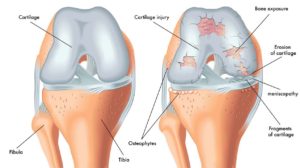Arthritis is often referred to as if it was one disease or condition. In fact, Arthritis is a family of over 100 different conditions that effect the musculoskeletal systems of the body, particularly the joints. Typically, arthritic conditions tend to effect the cartilage covering of the joints, often resulting in inflammation and damage to this cartilage covering. This cartilage acts as a protective cushioning on the ends of the bone, which allow the joint to glide smoothly. Damage to this cartilage covering often results in stiff and painful movement of the joint.
 There are many types of arthritis, with perhaps the most well know being osteoarthritis or OA. In normal joints, a firm, rubbery material called cartilage covers the end of each bone. Cartilage provides a smooth, gliding surface for joint motion and acts as a cushion between the bones. In OA, the cartilage gradually breaks down, causing pain, swelling and problems moving the joint. It is essentially wear and tear to the cartilage covering of the joints which has occurred over quite a long period of time. This may develop for a number of reasons such as being overweight and thus placing more load and stress onto the joint surface, previous injury to the joint which has damaged the cartilage, weak muscles which result in poorly controlled movement of the joint, lots of repetitive loading of a particular joint of the body and a genetic predisposition to having cartilage which wears more easily. In the final stages of OA, the cartilage wears away and bone rubs against bone leading to joint damage and more pain. The most commonly effected joints are the knee, hip and spine. Although OA occurs in people of all ages, it is most common in people older than 65. Currently one in two adults will develop symptoms of knee OA during their lives. One in four adults will develop symptoms of hip OA by age 85. The incidence of this pathology is expected to dramatically increase over the next 2 decades.
There are many types of arthritis, with perhaps the most well know being osteoarthritis or OA. In normal joints, a firm, rubbery material called cartilage covers the end of each bone. Cartilage provides a smooth, gliding surface for joint motion and acts as a cushion between the bones. In OA, the cartilage gradually breaks down, causing pain, swelling and problems moving the joint. It is essentially wear and tear to the cartilage covering of the joints which has occurred over quite a long period of time. This may develop for a number of reasons such as being overweight and thus placing more load and stress onto the joint surface, previous injury to the joint which has damaged the cartilage, weak muscles which result in poorly controlled movement of the joint, lots of repetitive loading of a particular joint of the body and a genetic predisposition to having cartilage which wears more easily. In the final stages of OA, the cartilage wears away and bone rubs against bone leading to joint damage and more pain. The most commonly effected joints are the knee, hip and spine. Although OA occurs in people of all ages, it is most common in people older than 65. Currently one in two adults will develop symptoms of knee OA during their lives. One in four adults will develop symptoms of hip OA by age 85. The incidence of this pathology is expected to dramatically increase over the next 2 decades.
Signs and Symptoms
- Joint pain and swelling.
- Pain increases when you are active (especially walking, up/down stairs, in/out cars, in/out chairs), but gets a little better with rest.
- Feeling of warmth in the joint.
- Stiffness, especially in the morning or when you have been sitting for a while.
- Crepitus when the joint moves.
Management
There is no cure for osteoarthritis. Once the cartilage has been worn, it does not regenerate. Treatment focuses largely on controlling the symptoms with medication such as anti-inflamatories, as well as activity modification to reduce stress and load on the affected joint. One of the most important parts of treating osteoarthritis is exercise. According to extensive clinical research, exercise therapy is very effective in reducing OA pain, specifically, exercises that maintain adequate muscle strength for well controlled loading of the joint. This prevents or slows the rate of further wear to the cartilage. Pilates is one form of exercise therapy that can help address both the postural variants and muscle weakness patterns commonly seen in patients with OA. Other techniques such as manual therapy, acupuncture, taping/bracing, walking appliances and activity modification may also be useful adjuncts in managing a patient with OA. In more severe cases intra-articular corticosteroid injections are prescribed. Where conservative management has failed, joint replacement surgery often needs to be considered and is generally able to provide significant relief of symptoms.
Article by Philip Ting
